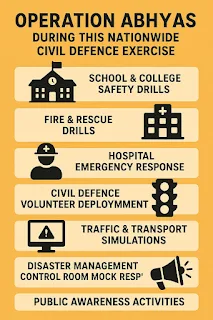Operation Abhyas (2025 Civil Defence Exercise) Explained: Civil Defence Exercises for National Safety
 |
| Operation Abhyas |
At the time of Operation Abhyas, which is a nationwide civil defence preparedness exercise, the government and citizens carry out a coordinated simulation of emergency response activities. It is designed to prepare the public and authorities for potential threats such as war, terrorist attacks, natural disasters, or nuclear emergencies.
🛡 What Happens During Operation Abhyas
Here’s what typically happens across the country during this operation:
🏫 1. School & College Safety Drills:
 |
| Civil Defence Exercise |
- Mock evacuations are conducted.
- Students are trained in:
- How to react during air raids
- Teachers explain emergency communication and first aid.
🚒 2. Fire & Rescue Drills:
- Fire brigades simulate rescue operations.
Teams demonstrate:
- Evacuation from buildings
- Rescue using ladders, ropes
- Emergency fire handling techniques
🏥 3. Hospital Emergency Response:
- Hospitals conduct mock mass casualty drills.
Staff are trained to:
- Handle chemical/biological/radiation emergencies
- Manage sudden influx of injured
- Practice triage (sorting of patients by severity)
🧯 4. Civil Defence Volunteer Deployment:
- Thousands of trained volunteers participate.
Their role includes:
- Public announcements and warnings
- Helping the elderly and disabled
- Crowd control and shelter setup
🛑 5. Traffic & Transport Simulations:
- Police simulate road blockades, air raid sirens, and blackouts.
Public transport staff are trained to:
- Halt operations on emergency command
- Assist with evacuations
🛰 6. Disaster Management Control Room Mock Response:
- Real-time simulation of war or disaster situations
Coordination between:
- National Disaster Response Force (NDRF)
- Home Ministry
- Local District Collectors & SPs
- They test how fast they can respond with supplies, teams, and medical aid
🧘 7. Public Awareness Activities:
Pamphlets, radio, and TV alerts educate the public on:
- What to do during air raids
- How to identify and report suspicious activity
- Emergency helpline numbers
🕒 Duration:
- Operation Abhyas is usually conducted over 1 day, but preparations begin weeks in advance.
🗺 Where?
- Conducted in major cities and selected districts across India (like Delhi, Mumbai, Hyderabad, Kolkata, Chennai, etc.)
🎯 Purpose of Operation Abhyas:
- Preparedness: Test national readiness for emergencies
- Coordination: Practice teamwork between government departments and local bodies
- Public Training: Educate civilians on what to do during disasters or attacks
- Technology Testing: Use of public address systems, emergency alert apps, drones, etc.
- Confidence Building: Reassure the public that the country is ready for any crisis
Key Objectives and Activities
Emergency Preparedness: Simulated scenarios such as air raids, fire emergencies, and rescue operations to test and improve the country's civil defence mechanisms.
Public Participation: Involved citizens across all age groups, from schoolchildren learning lifesaving techniques to elders participating in evacuation drills.
Infrastructure Drills: Conducted drills at key public infrastructures like airports and power stations to enhance preparedness for potential real-world emergencies.
Inter-Agency Coordination: Engaged various departments, including police, fire services, medical teams, and municipal bodies, to ensure a coordinated response during emergencies.
This exercise was notably significant as it was the most extensive since the 1971 India-Pakistan war, aiming to bolster India's national security and disaster response infrastructure.




0 Comments